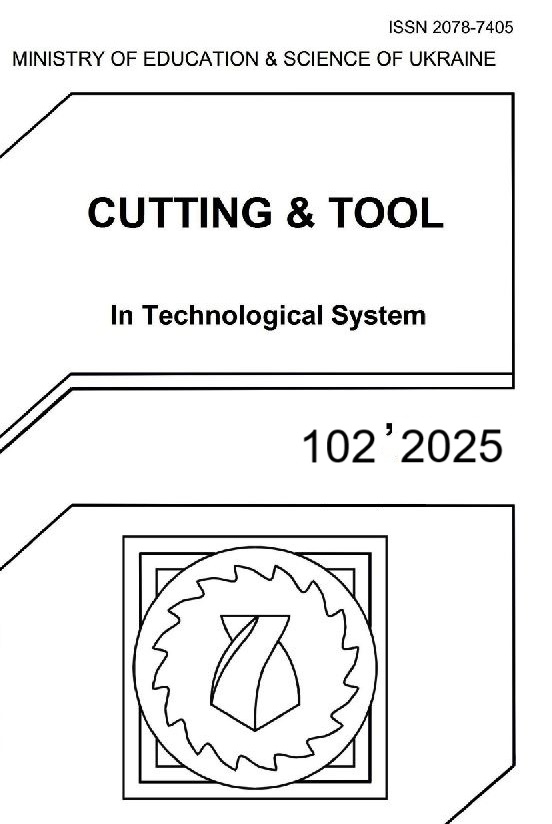CARBON DIOXIDE EMISSIONS AND SURFACE ROUGHNESS ANALYSIS DURING DIAMOND BURNISHING
DOI:
https://doi.org/10.20998/2078-7405.2025.102.07Keywords:
energy efficiency, sustainable development, slide diamond burnishing, surface finishAbstract
Carbon emissions are one of the most pressing environmental problems of our time. CO2 emitted by human activities, especially industry, transport and energy production, is a major contributor to the gradual warming of the Earth's atmosphere. The aim of my research is to investigate the relationship between carbon dioxide emissions and surface roughness by varying different technological parameters during diamond burnishing. In the first chapter of this paper, we will review the current state of the art and literature on carbon dioxide emissions and then, based on a chosen methodology, we will show how carbon dioxide emissions from diamond polishing can be quantified. Following the calculation, we will present the technological parameters used for the machining, the test pieces on which we measured surface roughness after diamond burnishing, and some additional calculations needed to evaluate the data. In the main part of the research, we will evaluate the calculated data using 2D and 3D surface roughness metrics, with a special focus on the characteristics of the Abbott-Firestone curve.
References
M. Tóth: Károsanyag-kibocsátás elemzése szikragyújtású motoron megújuló komponenseket tartalmazó tüzelőanyagok használata esetén motorfékpadi környezetben, in OGÉT 2024 - XXXII. Nemzetközi Gépészeti Konferencia, 2024, pp. 446–451.
Xin Yao, Wei Yan, Hua Zhang, .Zhigang Jiang, .Shuo Zhu: A Framework for Carbon Emission Quantification of Mechanical Machining Process Based on IoT and MEFA, IFAC-PapersOnLine, Volume 53, Issue 5, 2020, рр. 25‒30, ISSN 2405-8963, https://doi.org/10.1016/j.ifacol.2021.04.079.
IEA (2024): CO2 Emissions in 2023, IEA, Paris https://www.iea.org/reports/co2-emissions-in-2023, Licence: CC BY 4.0.
Ding, Hui & Guo, Dengyue & Cheng, Kai & Cui, Qi.: An investigation on quantitative analysis of energy consumption and carbon footprint in the grinding process. Proceedings of the Institution of Mechanical Engineers, Part B: Journal of Engineering Manufacture. 228. 950‒956. 10.1177/0954405413508280.
Dahmus J and Gutowski T.: An environmental analysis of machining. In: 2004 ASME International Mechanical Engineering Congress (IMECE) and RD&D Expo, Anaheim, CA, 13–19 November 2004, pp.1–10. New York: ASME.
Tridech S and Cheng K.: Low carbon manufacturing: characterisation, theoretical models and implementation. Int J of Man Res 2011; 6(2): 110–121.
Li W and Kara S.: An empirical model for predicting energy consumption of manufacturing processes: a case of turning process. Proc IMechE, Part B: J Engineering Manufacture 2011; 225(9): 1636–1646.
Dietmair A and Verl A.: A generic energy consumption model for decision making and energy efficiency optimisation in manufacturing. Int J Sustain Eng 2009; 2(2): 123–133.
J. Jeswiet and S. Kara: Carbon emissions and CES in manufacturing, CIRP Annals—Manufacturing Technology, vol. 57, no. 1, pp. 17–20, 2008.
Y.-C.Choi and P. Xirouchakis: Aproduction planning in highly automated manufacturing system considering multiple process plans with different energy requirements, The International Journal of AdvancedManufacturing Technology, vol. 70, no. 5–8, pp. 853–867, 2014.
K. Fang, N. Uhan, F. Zhao, and J. W. Sutherland: A newapproach to scheduling in manufacturing for power consumptionand carbon footprint reduction, Journal of ManufacturingSystems, vol. 30, no. 4, pp. 234–240, 2011.
A. Laurent, S. I. Olsen, and M. Z. Hauschild: Carbon footprintas environmental performance indicator for the manufacturingindustry, CIRP Annals-Manufacturing Technology, vol. 59, no.1, pp. 37–40, 2010.
C. Herrmann and S. Thiede, Process chain simulation tofoster energy efficiency in manufacturing, CIRP Journal of Manufacturing Science and Technology, vol. 1, no. 4, pp. 221–229, 2009.
C. B. Li, Y. Tang, L. G. Cui, and P. Y. Li, A quantitative approach to analyze carbon emissions of CNC-basedmachining systems, Journal of Intelligent Manufacturing, 2013.
https://ember-climate.org/data-catalogue/yearly-electricity-data/ (2024. 12. 12.)
Hannah Ritchie, Pablo Rosado and Max Roser: “Energy”. Data adapted from Ember, Energy Institute. Retrieved from https://ourworldindata.org/grapher/carbon-intensity-electricity (2024. 12. 12.)
Varga, G., Smolnicki, S., Babič, M., Caesarendra, W.: Energy Efficiency Analysis When Grinding and Diamond Burnishing of Components, In: Gençyılmaz, M. Güneş; Durakbasa, Numan M. (ed.-s.) Towards Industry 5.0 : Selected Papers from ISPR2022, Cham, Svájc : Springer International Publishing (2023) pp. 378‒396.
Coefficient of Friction Equation and Table Chart, Engineers Edge: https://www.engineersedge.com/coeffients_of_friction.htm% 20 (2024. 12. 13.)
S. Szilárd and V. Gyula: Energy efficiency study of diamond burnishing using 3D surface roughness parameters, in MECHATRONIKA, VÝROBNÁ TECHNIKA, DIGITÁLNY PODNIK: najnovšie úspechy, výzvy, trendy, 2023, pp. 47–57.
S. Smolnicki and G. Varga: Analysis of the Abbott-Firestone curve on a diamond-burnished surface, Cutting and tool in technological systems, vol. 100, pp. 119–138, 2024.
M. Tomov, P. Karolczak, H. Skowronek, P. Cichosz, M. Kuzinovski: Mathematical Modelling of Core Roughness Depth During Hard Turning. In: Królczyk, G., Niesłony, P., Królczyk, J. (eds) Industrial Measurements in Machining. IMM 2019. Lecture Notes in Mechanical Engineering. Springer, Cham. 2020. https://doi.org/10.1007/978-3-030-49910-5_1
Downloads
Published
Issue
Section
License
Copyright Notice
Authors who publish with this Collection agree to the following terms:
1. Authors retain copyright and grant the Collection right of first publication with the work simultaneously licensed under a Creative Commons Attribution License that allows others to share the work with an acknowledgement of the work's authorship and initial publication in this Collection.
2. Authors are able to enter into separate, additional contractual arrangements for the non-exclusive distribution of the Collection's published version of the work (e.g., post it to an institutional repository or publish it in a book), with an acknowledgement of its initial publication in this Collection.
3. Authors are permitted and encouraged to post their work online (e.g., in institutional repositories or on their website) prior to and during the submission process, as it can lead to productive exchanges, as well as earlier and greater citation of published work.

